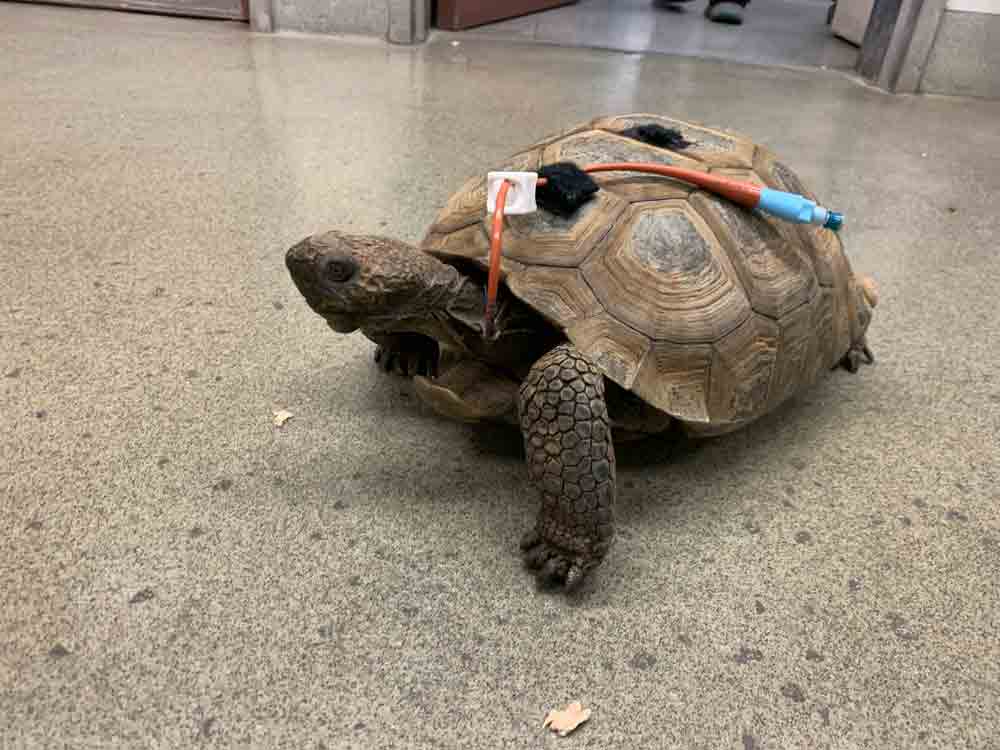Tortie, a California desert tortoise (Gopherus agassizii) who has grown up with the same family for more than 60 years recently underwent successful s
Tortie, a California desert tortoise (Gopherus agassizii) who has grown up with the same family for more than 60 years recently underwent successful surgery at the UC Davis veterinary hospital to remove a bladder stone. The stone was discovered after his new keeper brought the tortoise to the vet for a wellness check.
Cal Dalrymple’s parents acquired the tortoise more than 60 years ago, way before Cal was born, and he had always wanted to keep him as a pet. When his parents passed away recently, Cal brought the tortoise to live with him and his wife. His wife Michelle, who is new to reptiles, began researching and made the decision to have Tortie come in to a veterinarian for a wellness examination. It was during the exam that something was discovered that concerned the veterinarian, so the reptile was referred to the UC Davis veterinary hospital’s Companion Exotic Animal Medicine and Surgery Service, according to a press release put out by the hospital.
The examination revealed that Tortie had a large bladder stone that was the size of a human fist and had to be surgically removed. Dr. David Guzman, chief of the Companion Exotic Animal Medicine and Surgery Service, and resident Dr. Mariana Sosa Higareda, conducted the successfully surgery, which involved endoscopically entering Tortie’s body cavity through an area in front of his back leg (prefemoral fossa), breaking up the stone in the body and removing it from the back leg. The doctors said if the stone was not removed, it would grow larger and could negatively impact the chelonian’s vital organs.
“Tortie is a great example of the importance of annual wellness examinations,” Dr. Guzman said in the press release. “Thankfully, his owners chose to get a hibernation consultation, but the stone could have been identified even earlier with an annual examination, and that smaller stone could’ve been removed much easier.”

Dr. David Guzman, chief of the Companion Exotic Animal Medicine and Surgery Service, and resident Dr. Mariana Sosa Higareda performing the surgery. Photo courtesy UC Davis veterinary hospital’s Companion Exotic Animal Medicine and Surgery Service.
The surgery, the less invasive of two methods to remove the bladder stone (the first involved an invasive cut through the bottom of the shell to remove the stone), was the first time Dr. Sosa Higareda performed it in her residency.
California Desert Tortoise Granted Temporary Endangered Species Status
“While this procedure is less invasive, it still presented some challenges,” Dr. Sosa Higareda said. “We needed to get good exposure to the bladder through such a small opening and also come up with techniques to break down such a large stone and remove the pieces.”

The bladder stone was broken up and successfully removed. Photo courtesy UC Davis veterinary hospital’s Companion Exotic Animal Medicine and Surgery Service.
In all, the surgery took three hours and the stone was completely broken down and successfully removed. The removal was confirmed by endoscopic examination and a post operative x-ray. He was outfitted with a feeding tube, and after a recheck examination at two weeks and six weeks post-surgery, Tortie’s feeding tube was removed and his keepers now say he has great energy and is eating well.
“It’s really a miracle what Dr. Sosa Higareda and the team were able to do,” Michelle Dalrymple said. “They put so much effort and concern into Tortie’s care. I was so appreciative. Tortie is absolutely back to his old self. He eats well and is active every day. He even seems to have a slight spring in his step since the procedure.”
The California desert tortoise was granted temporary endangered species status by the California Fish and Game Commission in October of 2020. The tortoise ranges from the Mojave and Sonoran deserts in Southern California and can also be found in Arizona, Nevada, as well as in areas in Mexico. It grows to about 8 to 10 lbs. and eats mostly weeds and leafy weeds in the wild. The desert tortoise is a protected species and it is speculated that more desert tortoises can be found in captivity than in the wild.


